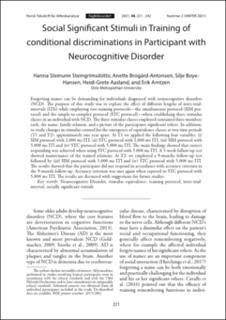Social significant stimuli in training of conditional discriminations in participant with neurocognitive disorder
Steingrimsdottir, Hanna Steinunn; Brogård-Antonsen, Anette; Boye-Hansen, Silje; Aasland, Heidi Grete; Arntzen, Erik
Peer reviewed, Journal article
Published version
Permanent lenke
https://hdl.handle.net/11250/2982709Utgivelsesdato
2021Metadata
Vis full innførselSamlinger
Originalversjon
Norsk Tidsskrift for Atferdsanalyse (NTA). 2021, 48 (2), 221-242.Sammendrag
Forgetting names can be demanding for individuals diagnosed with neurocognitive disorders (NCD). The purpose of this study was to explore the effect of different lengths of inter-trialintervals (ITIs) while employing two training protocols—the simultaneous protocol (SIM protocol) and the simple-to-complex protocol (STC protocol)—when establishing three stimulus classes in an individual with NCD. The three stimulus classes employed contained three members each: the name, family relation, and a picture of the participants significant others. In addition, to study changes in stimulus control for the emergence of equivalence classes at two time periods (T1 and T2), approximately one year apart. At T1 we applied the following four variables: (i) SIM protocol with 2,000 ms ITI, (ii) STC protocol with 2,000 ms ITI, (iii) SIM protocol with 5,000 ms ITI and (iv) STC protocol with 5,000 ms ITI. The main findings showed that correct responding was achieved when using STC protocol with 5,000 ms ITI. A 5-week follow-up test showed maintenance of the trained relations. At T2, we employed a 9-months follow-up test followed by (iii) SIM protocol with 5,000 ms ITI and (iv) STC protocol with 5,000 ms ITI. The results showed that the participant did not respond in accordance with accuracy criterion in the 9-month follow-up. Accuracy criterion was met again when exposed to STC protocol with 5,000 ms ITI. The results are discussed with suggestions for future studies.
